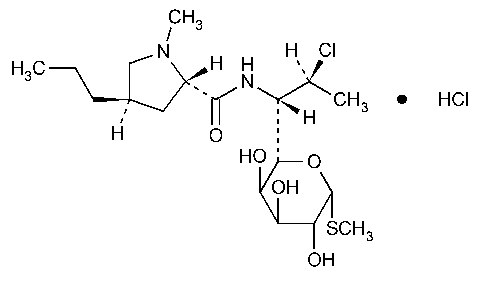Clindamycin Hydrochloride
L-threo-a-D-galacto-Octopyranoside,methyl 7-chloro-6,7,8-trideoxy-6-[[(1-methyl-4-propyl-2-pyrrolidinyl)-carbonyl]amino]-1-thio-,(2S-trans)-,monohydrochloride.
Methyl 7-chloro-6,7,8-trideoxy-6-(1-methyl-trans-4-propyl-L-2-pyrrolidinecarboxamido)-1-thio-L-threo-a-D-galacto-octopyranoside monohydrochloride [21462-39-5].
Monohydrate 479.47 [58207-19-5].
»Clindamycin Hydrochloride is the hydrated hydrochloride salt of clindamycin,a substance produced by the chlorination of lincomycin.It has a potency equivalent to not less than 800µg of clindamycin (C18H33ClN2O5S)per mg.
Packaging and storage—
Preserve in tight containers.
Identification,Infrared Absorption á197Mñ.
Crystallinity á695ñ:
meets the requirements.
pHá791ñ:
between 3.0and 5.5,in a solution containing 100mg per mL.
Water,Method Iá921ñ:
between 3.0%and 6.0%.
Related compounds—
Mobile phase—
Prepare as directed in the Assay.
Standard solution—
Dissolve accurately weighed quantities of USP Lincomycin Hydrochloride RSand USP Clindamycin Hydrochloride RSquantitatively in Mobile phaseto obtain a solution having known concentrations of about 0.5mg per mLof USP Lincomycin Hydrochloride RSand 1mg per mLof USP Clindamycin Hydrochloride RSper mL.Transfer 10.0mLof this solution to a 100-mLvolumetric flask,dilute with Mobile phaseto volume,and mix.
Test solution—
Transfer about 125mg of Clindamycin Hydrochloride,accurately weighed,to a 25-mLvolumetric flask,dissolve in and dilute with Mobile phaseto volume,and mix.
Chromatographic system
(see Chromatography á621ñ)—The liquid chromatograph is equipped with a 210-nm detector and a 4.6-mm ×25-cm column that contains 5-µm packing L1.The flow rate is about 1mLper minute.Chromatograph the Standard solution,and record the peak responses as directed for Procedure:the relative retention times are about 0.4for lincomycin,0.65for clindamycin B,0.8for 7-epiclindamycin,and 1.0for clindamycin.
Procedure—
Separately inject equal volumes (about 10µL)of the Test solutionand the Standard solution,and record the chromatograms for a period of time that is six times the retention time of clindamycin.Calculate the percentage of lincomycin in the Clindamycin Hydrochloride taken by the formula:
2.5(CLPL/W)(rU/rS),
in which CLis the concentration,in mg per mL,of USP Lincomycin Hydrochloride RSin the Standard solution;PLis the potency,in µg of lincomycin (C18H34N2O6S)per mg,of USP Lincomycin Hydrochloride RS;Wis the weight,in mg,of Clindamycin Hydrochloride taken to prepare the Test solution;and rUand rSare the lincomycin peak responses obtained from the Test solutionand the Standard solution,respectively.Calculate the percentage of all other related compounds in the Clindamycin Hydrochloride taken by the formula:
2.5(CP/W)(ri/rC),
in which Cis the concentration,in mg per mL,of USP Clindamycin Hydrochloride RSin the Standard solution;Pis the potency,in µg,of clindamycin (C18H33ClN2O5S)per mg,of USP Clindamycin Hydrochloride RS;Wis the weight,in mg,of Clindamycin Hydrochloride taken to prepare the Test solution;riis the response of an individual related compound,other than lincomycin,in the chromatogram obtained from the Test solution;and rCis the clindamycin peak response in the chromatogram obtained from the Standard solution.Not more than 4.0%of 7-epiclindamycin and not more than 2.0%of clindamycin Bis found,the percentage of any other individual related compound is not more than 1.0%,and the total of all related compounds,including lincomycin,is not more than 6.0%.
Assay—
Mobile phase—
Dissolve 6.8g of monobasic potassium phosphate in 1liter of water,and adjust with 8Npotassium hydroxide to a pHof 7.5.Prepare a filtered and degassed mixture of this buffer solution and acetonitrile (550:450).Make adjustments if necessary (see System Suitabilityunder Chromatography á621ñ).[NOTE—Increasing the proportion of acetonitrile in the Mobile phase decreases the retention time,and decreasing it increases the resolution between 7-epiclindamycin and clindamycin.]
Standard preparation—
Dissolve an accurately weighed quantity of USP Clindamycin Hydrochloride RSquantitatively in Mobile phaseto obtain a solution having a known concentration of about 1mg per mL.
Assay preparation—
Transfer about 125mg of Clindamycin Hydrochloride,accurately weighed,to a 25-mLvolumetric flask,dissolve in and dilute with Mobile phaseto volume,and mix.Transfer 5.0mLof this solution to a 25-mLvolumetric flask,dilute with Mobile phaseto volume,and mix.
Chromatographic system
(see Chromatography á621ñ)—The liquid chromatograph is equipped with a 210-nm detector and a 4.6-mm ×25-cm column that contains 5-µm packing L1.The flow rate is about 1mLper minute.Chromatograph the Standard preparation,and record the peak responses as directed for Procedure:the resolution,R,between the clindamycin Bpeak and the 7-epiclindamycin peak is not less than 2.4;the resolution,R,between the 7-epiclindamycin peak and the clindamycin peak is not less than 3.0;the column efficiency calculated from the clindamycin peak is not less than 4000;the tailing factor for the clindamycin peak is not more than 1.2;and the relative standard deviation for the clindamycin peak is not more than 1.0%.
Procedure—
Separately inject equal volumes (about 10µL)of the Standard preparationand the Assay preparationinto the chromatograph,record the chromatograms for a period of time that is about twice the retention time of the clindamycin peak,and measure the clindamycin peak areas.Calculate the potency,in µg of clindamycin (C18H33ClN2O5S)per mg,of the Clindamycin Hydrochloride taken by the formula:
125(CP/W)(rU/rS),
in which Cis the concentration,in mg per mL,of USP Clindamycin Hydrochloride RSin the Standard preparation;Pis the potency,in µg of clindamycin per mg,of USP Clindamycin Hydrochloride RS;Wis the weight,in mg,of Clindamycin Hydrochloride taken to prepare the Assay preparation;and rUand rSare the clindamycin peak area responses obtained from the Assay preparationand the Standard preparation,respectively.
Auxiliary Information—
Staff Liaison:William W.Wright,Ph.D.,Scientific Fellow
Expert Committee:(PA7)Pharmaceutical Analysis 7
USP28–NF23Page 493
Phone Number:1-301-816-8335
